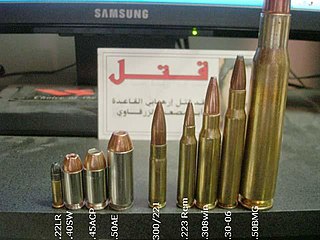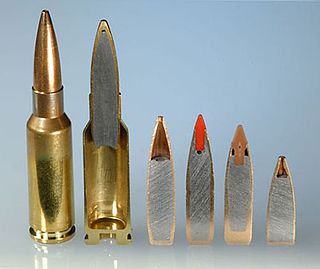
The 5.56×45mm NATO is a rimless bottlenecked intermediate cartridge family developed in the late 1970s in Belgium by FN Herstal. It consists of the SS109, L110, and SS111 cartridges. On 28 October 1980, under STANAG 4172, it was standardized as the second standard service rifle cartridge for NATO forces as well as many non-NATO countries. Though they are not entirely identical, the 5.56×45mm NATO cartridge family was derived from and is dimensionally similar to the .223 Remington cartridge designed by Remington Arms in the early 1960s.
The 7.62 mm caliber is a nominal caliber used for a number of different cartridges. Historically, this class of cartridge was commonly known as .30 caliber, the equivalent in Imperial and United States Customary measures. It is most commonly used in hunting cartridges. The measurement equals 0.30 inches or three decimal lines, written .3″ and read as three-line.

Rifling is the term for helical grooves machined into the internal surface of a firearms's barrel for imparting a spin to a projectile to improve its aerodynamic stability and accuracy. It is also the term for creating such grooves.

In guns, particularly firearms, caliber is the specified nominal internal diameter of the gun barrel bore – regardless of how or where the bore is measured and whether the finished bore matches that specification. It is measured in inches or in millimeters. In the United States it is expressed in hundredths of an inch; in the United Kingdom in thousandths; and elsewhere in millimeters. For example, a US "45 caliber" firearm has a barrel diameter of roughly 0.45 inches (11 mm). Barrel diameters can also be expressed using metric dimensions. For example, a "9 mm pistol" has a barrel diameter of about 9 millimeters. Since metric and US customary units do not convert evenly at this scale, metric conversions of caliber measured in decimal inches are typically approximations of the precise specifications in non-metric units, and vice versa.

Heat capacity or thermal capacity is a physical property of matter, defined as the amount of heat to be supplied to an object to produce a unit change in its temperature. The SI unit of heat capacity is joule per kelvin (J/K).

The 6.8mm Remington Special Purpose Cartridge is a rimless bottlenecked intermediate rifle cartridge that was developed by Remington Arms in collaboration with members of the U.S. Army Marksmanship Unit and United States Special Operations Command to possibly replace the 5.56 NATO cartridge in short barreled rifles (SBR) and carbines. Based on the .30 Remington cartridge, it is midway between the 5.56×45mm NATO and 7.62×51mm NATO in bore diameter. It uses the same diameter bullet as the .270 Winchester hunting cartridge.

The gauge of a firearm is a unit of measurement used to express the inner diameter of the barrel.
The 5.45×39mm cartridge is a rimless bottlenecked intermediate cartridge. It was introduced into service in 1974 by the Soviet Union for use with the new AK-74. The 5.45×39mm gradually supplemented and then largely replaced the 7.62×39mm cartridge in Soviet and Warsaw Pact service as the primary military service rifle cartridge.

The .300 Whisper is a CIP standard cartridge in the Whisper family, a group of cartridges developed in the early 1990s by J.D. Jones of SSK Industries. It was developed as a multi-purpose cartridge, capable of utilizing relatively lightweight bullets at supersonic velocities as well as heavier bullets at subsonic velocities.
The 7.62×45mm is a rimless bottlenecked intermediate rifle cartridge developed in Czechoslovakia. It is fired by the Czech Vz. 52 rifle, Vz. 52 light machine gun, and ZB-53 machine gun. The cartridge was later dropped from use when the Czech converted to the standard 7.62×39mm Warsaw Pact cartridge of the Soviet Union. Its muzzle velocity and muzzle energy are slightly higher than that of the 7.62×39mm cartridge, and is on par with the .30-30 Winchester cartridge, with equivalent projectiles.

The OTs-14-4 "Groza-4" is a Russian selective fire bullpup assault rifle chambered for the 9×39mm subsonic cartridge. It was developed in the 1990s at the TsKIB SOO in Tula, Russia.

The 6.5mm Grendel is an intermediate cartridge jointly designed by British-American armorer Bill Alexander, competitive shooter Arne Brennan and Lapua ballistician Janne Pohjoispää, as a low-recoil, high-precision rifle cartridge specifically for the AR-15 platform at medium/long range. It is an improved variation of the 6.5mm PPC.
The 5.8×42mm / DBP87 is a military bottlenecked intermediate cartridge developed in the People's Republic of China. There is limited information on this cartridge, although the People's Liberation Army claims that it is superior to the 5.56×45mm NATO and Soviet 5.45×39mm cartridges.

An intermediate cartridge is a rifle/carbine cartridge that has significantly greater power than a pistol cartridge but still has a reduced muzzle energy compared to fully powered cartridges, and therefore is regarded as being "intermediate" between traditional rifle and handgun cartridges.
.22 caliber, or 5.6 mm caliber, refers to a common firearms bore diameter of 0.22 inch (5.6 mm).

The Beretta ARX160 is an Italian modular assault rifle manufactured by Beretta. Developed for the Italian Armed Forces as part of the Soldato Futuro program, the ARX160 was launched in 2008 as a commercial weapon system independent from the Soldato Futuro ensemble, complete with a companion single-shot 40×46mm NATO low-velocity grenade launcher, called the GLX160, which can be mounted underneath the rifle or used with an ad hoc stock system as a stand-alone weapon.

The .300 AAC Blackout, also known as 7.62×35mm, is an intermediate cartridge developed in the United States by Advanced Armament Corporation (AAC) for use in the M4 carbine. The cartridge yields increased performance in shorter barrels and effective subsonic performance for silencer use when compared to 5.56mm NATO. The .300 AAC Blackout uses standard 5.56mm NATO magazines and components with the exception of the barrel.

The CZ 805 BREN is a gas-operated modular assault rifle designed and manufactured by Česká zbrojovka Uherský Brod. The modular design enables users to change the calibre of the weapon to 5.56×45mm NATO or 7.62×39mm intermediate cartridges by quick change of barrel with gas tubes, breech block, magazine bay and magazine.

The 7.62×37mm Musang is an assault rifle cartridge introduced in 2012 developed and manufactured in the Philippines by the Government Arsenal for use by the military in special operations and close quarter battle.
The .277 Wolverine (6.8x39mm) is a wildcat cartridge. It is a multi-purpose mid-power cartridge with increased ballistic performance over the AR-15's traditional .223 Remington cartridge. The use of a modified 5.56 case means that at minimum, only a new barrel is needed to convert any 5.56-based firearm to .277 Wolverine.
















